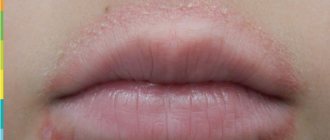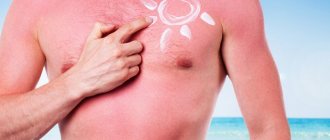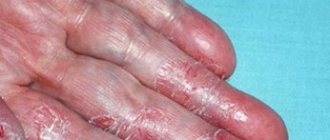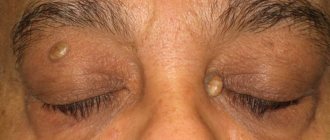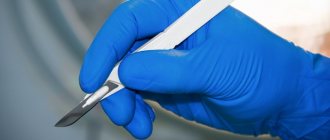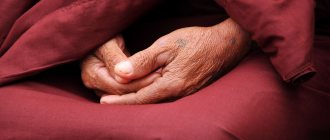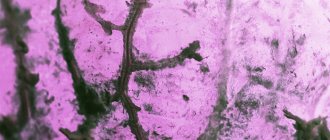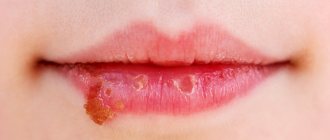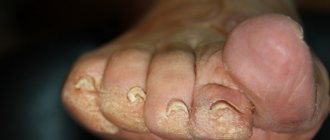Vladimir Yashin, a general practitioner and teacher at Moscow Medical School No. 13, talks about how to cope with the disease .
Hidradenitis occurs in both adults and children. The disease manifests itself in purulent inflammation of the sweat glands and most often develops in the armpits, and sometimes in the perineal area. In fact, we are talking about an infection caused by hemolytic staphylococcus. Microbes penetrate into the sweat glands through their excretory ducts or small wounds and abrasions, as well as through the lymphogenous route (through lymphatic vessels).
Terrible view!
Hidradenitis begins with discomfort, burning and redness in the armpit. Then dense, painful round or oval nodules appear in this place. Gradually they increase in volume, swell and become like papillae (by the way, that’s why the disease is popularly called “bitch udder”). In this case, the person feels unwell and severe pain in the shoulder joint when moving, so he has to keep his arm in an abducted or elevated position. After some time, the nodules open and pus is released.
Related article: Lump under the armpit, causes and treatment →
What factors lead to diaper rash in the armpits of newborns?
- Temperature and humidity are too high;
- Clothes that are not selected for the weather or fit. Too hot, tight clothes do not allow air to pass through, and also rub the skin of the armpits.
- Incorrectly selected cosmetics for the skin of a newborn, as well as their excessive use. Such products disrupt the acid balance and increase skin sensitivity. This item also includes the use of irritant products for cleansing the skin in children, these include soaps, detergents, wet wipes with fragrance/alcohol;
- Lack or insufficient use of air baths;
- Rare bathing of the child, especially in the hot season;
- Skin injury: friction of diapers, excessive washing with intensive cleansing;
- Increased body temperature due to viral diseases.
To treat or not to treat?
| Important! | |
| Without proper treatment, hidradenitis, like any disease, can be neglected. In this case, in addition to discomfort, the temperature may rise (accompanied by a headache and a feeling of general weakness). In addition, poorly treated hidradenitis can recur dozens of times until the patient begins treatment. | |
If signs of the disease occur, do not delay visiting a doctor, who will prescribe appropriate treatment. As a rule, it is complex and involves, in particular, applying bandages to the affected area with an ointment that has an antimicrobial effect and taking antibiotics. Ultraviolet irradiation and UHF therapy have a good effect. The patient is prescribed vitamins and recommended a diet rich in vegetables and fruits. It is necessary to exclude spicy foods and seasonings from the menu, limit sweets, and also not drink alcohol and stop smoking.
Article on the topic
Are you sweating a lot? Pros and cons of different treatments for hyperhidrosis
In severe cases, when conservative treatment does not bring the desired effect, surgery to remove the abscess and nearby dead tissue is indicated.
Armpit hyperhidrosis
Treatment for underarm hyperhidrosis may include hygiene measures, physical therapy, injections and surgical techniques. Their use is justified in patients with essential hyperhidrosis. In case of secondary axillary hyperhidrosis, it is advisable to identify and eliminate the cause of excessive sweating, however, symptomatic treatment methods can be successfully used in this category of patients.
Hygienic care
Patients with HDSS severity 1 and 2 can cope with the problem by making small adjustments to their daily body care. At 3 and 4 degrees of severity, means that control sweating have an auxiliary value and are used simultaneously with conservative treatment methods and cosmetic procedures. To make life easier for a patient with excessive sweating:
- Medical antiperspirants.
The main active component of this group of products is aluminum hexachlorohydrate, less often aluminum chloride with a concentration of 20-40%. It penetrates the ducts of the sweat glands and clogs them for a while. A prerequisite for the effectiveness of a medical antiperspirant is its application to dry skin. This limits the use of drugs in patients with grade 4 hyperhidrosis severity on the HDSS scale. - Hygienic liners for armpits.
The sticky side of the inserts is fixed to the clothing from the inside out in the armhole area. The absorbent surface prevents sweat stains from appearing. The active ingredients with which the material of the liners is impregnated inhibit the growth of bacteria and relieve a person from an unpleasant odor. Underarm pads can be used simultaneously with hygienic or medical antiperspirants.
Conservative treatment
Indications and contraindications for conservative treatment are determined during a dermatological appointment after a comprehensive examination of the patient. Taking into account age, the presence of concomitant diseases, and the technical equipment of the clinic, the patient may be recommended:
- Anticholinergic drugs.
Enteral administration of drugs and their local introduction into the skin through iontophoresis are possible. Local treatment is preferable, since medications taken orally can cause adverse reactions. Glycopyrolate is used most often among the drugs in this group. The method has limited effectiveness in correcting sweating. - Ultra-high frequency therapy (UHF).
Under the influence of an electromagnetic field of a certain frequency, local heating of tissue occurs. An increase in temperature induces thermolysis of sweat glands in certain areas of the body. Treatment involves performing 4 procedures with an interval of 1 week. This allows you to achieve a pronounced reduction in sweating in the armpits, eliminating the unpleasant odor of sweat for up to 6 months.
Cosmetology procedures
Injectables and hardware treatments can be used to combat excessive sweating. The advantage of the methods used in cosmetology is their versatility: several aesthetic problems can be eliminated in one procedure. Most often used in the fight against sweating are:
- Botox injections.
The administration of botulinum toxin type A preparations normalizes sweating for 4-6 months. To inject one axillary area, 70 to 150 units of the drug are required. For most patients, injections once a year in the spring are sufficient to avoid discomfort when wearing light, revealing clothing during the warmer months. - Laser treatment.
The destruction of the glands is carried out using a micro-cannula, which is inserted into the dermis through small punctures. One procedure is enough to reduce sweating by 80%. Laser treatment is performed under local anesthesia on an outpatient basis. As a rule, no compensatory reactions are observed after the procedure.
Surgery
In most cases, conservative treatment can reduce the intensity of pathological manifestations to an acceptable level for a long time. Surgical operations are indicated for a limited number of people who have not been able to achieve improvement in other ways. Currently, two main methods are used:
- Excision of the skin of the axillary area.
Removal of the skin of the axillary vault is a radical method of treating localized hyperhidrosis, which is used only if conservative treatment methods fail. The edges of the wound are pulled together and stitched. If it is not possible to reduce them, a skin transplant is performed. - Curettage and liposuction
. The cannula for liposuction during curettage is inserted under the skin to a depth of 3-4 mm, where most of the eccrine glands are located. One scraping is enough to significantly reduce armpit sweating. During liposuction of problem areas, the nerve endings that go to the skin in the fatty tissue are injured. This also helps reduce moisture release.
Prevent and do not treat
Prevention of hidradenitis lies primarily in observing the rules of personal hygiene. This applies not only to adults, but also to children who also have this disease. Parents should accustom them to water procedures, monitor neatness, and prevent the appearance of diaper rash in the armpits. Since small wounds and abrasions can become a gateway for infection, people susceptible to this disease should not often shave their armpit hair - health is more important than aesthetics.
It is recommended to treat the skin in this area with a 10% solution of camphor alcohol and periodically carry out ultraviolet irradiation. It is difficult to overestimate the importance of a balanced diet, which is an important means of preventing hidradenitis. In addition, it is important to carry out hardening procedures to strengthen the immune system.
What is diaper rash?
Diaper rash of the skin of a newborn is an inflammation of the skin folds that appears as a result of friction of the skin surfaces in contact with each other, as well as as a result of the irritating effect of skin secretion products and the negative effects of certain external factors.
One of the most common locations for diaper rash in a newborn's skin is the armpits. Due to the fact that the skin of the armpits is very thin and sensitive, active friction between the skin occurs, and little air gets into this area; diaper rash in this area bothers a large number of babies and, of course, their mothers.
Treatment of diaper rash in the armpits of a newborn
If it is still not possible to prevent diaper rash in a child’s armpits, then certain agents with drying, anti-inflammatory and antibacterial properties are used for treatment, for example:
Products based on dexapanthenol.
The use of dexapanthenol is due to its good penetration and high concentration in the skin when the substance is used in the form of a water-in-oil emulsion. Dexapanthenol acts as a humectant, increasing hydration of the upper layer of the epidermis, reducing transepidermal moisture loss, while maintaining the softness and elasticity of the skin. The most significant effects of dexapanthenol are anti-inflammatory activity, healing, and regenerative properties.
Preparations based on dexpanthenol actively affect the symptoms of diaper rash. Dry skin, peeling, itching, redness, erosion and even cracks usually occur in the 3rd week of daily use of the drug.
Products based on benzalkonium and cetrimide.
These active substances also have antiseptic, antimicrobial and anti-inflammatory properties and have proven themselves to be effective when used in children with diaper rash.
Talker products based on talc and zinc oxide.
These substances have drying and healing properties during the appearance of weeping, pustules and microcracks.
Antibacterial and antifungal external preparations.
These remedies are used only when a secondary infection occurs and only after consultation with a pediatrician or dermatologist, because have a number of contraindications and side effects.
It is worth noting that bathing in diluted potassium permanganate and herbal decoction is NOT recommended due to a number of side effects - increased dry skin, allergic reactions to herbs.
Remember that the appearance of diaper rash is easier to prevent than to treat, but if you do encounter diaper rash in the armpits of a newborn, do not panic or worry. It is important to continue to adhere to the prevention recommendations and immediately consult a doctor to clarify the diagnosis and prescribe individual treatment.
What does diaper rash look like under the armpits?
There are 3 degrees of diaper rash in the armpits of infants, which develop gradually:
- I degree - moderate hyperemia (redness) of the skin without visible violation of its integrity;
- II degree - bright red inflammation, sometimes accompanied by erosions;
- III degree - weeping areas of inflamed skin that appear as a result of numerous erosions merging with each other; the formation of ulcers is also possible.
At this degree, erythema extends beyond the armpits and can affect the skin of the chest and upper extremities.
Most often, the addition of bacterial or fungal flora occurs precisely with the third degree of diaper rash. Signs of a bacterial infection include severe hyperemia with discharge, blisters and pustules with white or yellowish contents.
Preventive measures include observing rules of skin hygiene and eliminating irritating factors that contribute to the development of diaper rash in newborns.
Prevention of diaper rash in the armpit skin consists of:
- cleansing the armpit area with running warm water. If it is not possible to wipe with water, you can use wet cleaning wipes without alcohol or fragrance. A number of studies have shown that the use of such wipes is effective for cleansing and hydrating the skin, as is bathing in water using fabric washes;
- bathing the baby in water with the addition of high-quality washing products, pharmaceutical brands approved by dermatologists;
- using frequent air baths after bathing the child;
- using a barrier care product or water-repellent emollient after swimming;
- using high-quality fabrics and materials when choosing clothes and diapers for a newborn;
- eliminating moments of skin trauma in the armpit area;
- using high-quality products for washing children’s clothes, without chemicals, parabens and other undesirable components.
